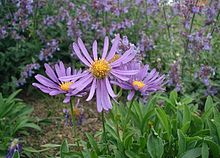Aster alpinus: Difference between revisions
Importing Wikidata short description: "Species of plant" (Shortdesc helper) |
added status to taxobox; fixed natserv reference |
||
| Line 2: | Line 2: | ||
{{taxobox |
{{taxobox |
||
|image = Aster-alpinus.JPG |
|image = Aster-alpinus.JPG |
||
|status=G5 |
|||
|status_system=TNC |
|||
|regnum = [[Plantae]] |
|regnum = [[Plantae]] |
||
|unranked_divisio = [[Angiosperms]] |
|unranked_divisio = [[Angiosperms]] |
||
| Line 22: | Line 24: | ||
}} |
}} |
||
'''''Aster alpinus''''', the '''alpine aster''' or '''blue alpine daisy''',<ref>[http://plants.usda.gov/java/profile?symbol=ASAL3 ''A. alpinus'' at USDA Plants Profile]</ref> is a [[species]] of [[flowering plant]] in the [[family (botany)|family]] Asteraceae, [[native species|native]] to the mountains of Europe (including the [[Alps]]), with a subspecies native to Canada and the United States. This [[herbaceous]] [[perennial plant|perennial]] has purple, pink or blue flowers in Summer |
'''''Aster alpinus''''', the '''alpine aster''' or '''blue alpine daisy''',<ref>[http://plants.usda.gov/java/profile?symbol=ASAL3 ''A. alpinus'' at USDA Plants Profile]</ref> is a [[species]] of [[flowering plant]] in the [[family (botany)|family]] Asteraceae, [[native species|native]] to the mountains of Europe (including the [[Alps]]), with a subspecies native to Canada and the United States. This [[herbaceous]] [[perennial plant|perennial]] has purple, pink or blue flowers in Summer. |
||
==Description== |
==Description== |
||
| Line 35: | Line 37: | ||
==Conservation== |
==Conservation== |
||
In Canadian provinces, towards eastern North America, the species is critically imperiled. However, in both Canadian provinces and US states, at north-western and southern parts, the species is apparently secure. |
In Canadian provinces, towards eastern North America, the species is critically imperiled. However, in both Canadian provinces and US states, at north-western and southern parts, the species is apparently secure.{{r|natserv}} |
||
==References== |
==References== |
||
{{reflist |
{{reflist|refs= |
||
<ref name=natserv> |
|||
{{cite web |
|||
|last1 = NatureServe |
|||
|date = 10 November 2020 |
|||
|title = Aster alpinus - Alpine Aster |
|||
|url = https://explorer.natureserve.org/Taxon/ELEMENT_GLOBAL.2.133527/Aster_alpinus |
|||
|website = NatureServe Explorer (explorer.natureserve.org) |
|||
|publisher = NatureServe |
|||
|access-date = 25 November 2020 |
|||
}} |
|||
</ref> |
|||
}} |
|||
{{Taxonbar|from=Q1342885}} |
{{Taxonbar|from=Q1342885}} |
||
Revision as of 18:31, 25 November 2020
| Aster alpinus | |
|---|---|

| |
| Scientific classification | |
| Kingdom: | |
| (unranked): | |
| (unranked): | |
| (unranked): | |
| Order: | |
| Family: | |
| Tribe: | |
| Genus: | |
| Species: | A. alpinus
|
| Binomial name | |
| Aster alpinus | |
| Synonyms[1] | |
| |
Aster alpinus, the alpine aster or blue alpine daisy,[2] is a species of flowering plant in the family Asteraceae, native to the mountains of Europe (including the Alps), with a subspecies native to Canada and the United States. This herbaceous perennial has purple, pink or blue flowers in Summer.
Description

It grows to be about 6–12 inches tall (15–30 cm). The bloom color may be pink, violet-lavender, or white-near white. In the UK this plant has gained the Royal Horticultural Society's Award of Garden Merit.[3]
It grows very slowly in clay, silt, loam, silty clay, sandy clay etc. types of soil. Its minimum pH scale is 6 and maximum pH scale is 7.5. It grows erectly in a 'single crown' form.
Ecology
It does better in generally cooler climates. Usually it is adapted to clay, silt, loam, silty clay, sandy clay, clay loam, silt loam, sandy loam, silty clay loam and sandy clay loam soils, and prefers low fertility. The plant can tolerate only a minimum temperature of -28 °C / -18.4F after the occurrence of cell damage. It can survive medium heat of fire and requires at least 90 frost free days for proper growth. It is herbaceous and attractive to bees, butterflies, and birds.
Conservation
In Canadian provinces, towards eastern North America, the species is critically imperiled. However, in both Canadian provinces and US states, at north-western and southern parts, the species is apparently secure.[4]
References
- ^ "Aster alpinus". Germplasm Resources Information Network. Agricultural Research Service, United States Department of Agriculture. Retrieved 4 January 2018.
- ^ A. alpinus at USDA Plants Profile
- ^ "RHS Plant Selector - Aster alpinus". Retrieved 15 April 2020.
- ^ NatureServe (10 November 2020). "Aster alpinus - Alpine Aster". NatureServe Explorer (explorer.natureserve.org). NatureServe. Retrieved 25 November 2020.

